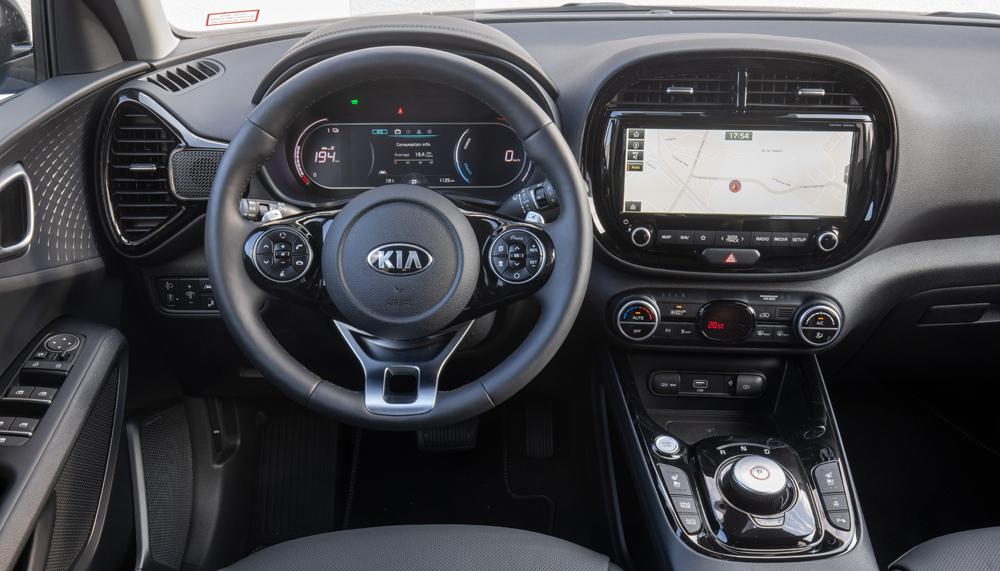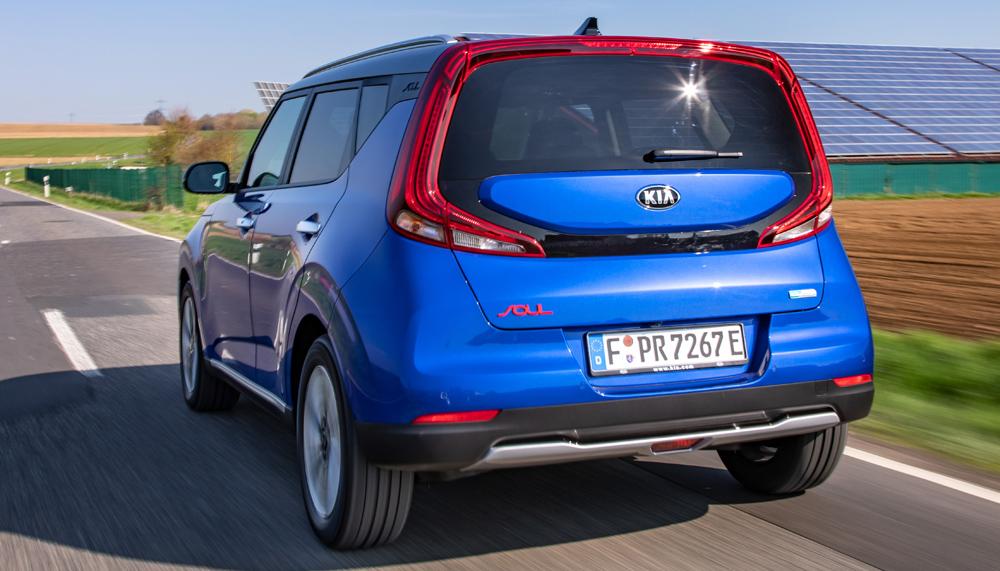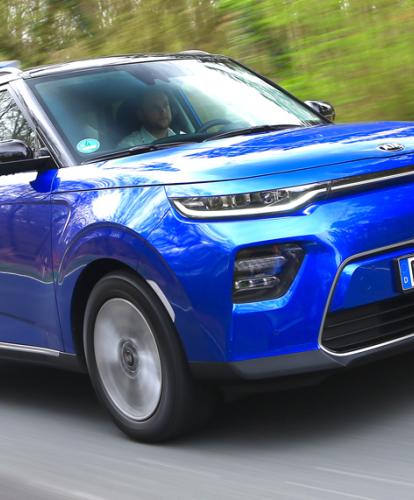We’ve driven the new Kia Soul EV at its European launch in Frankfurt, to get an early impression as to how the pure-electric crossover will do when it arrives on UK shores later this year.
The out-going Kia Soul EV has been around for some time now, and is regarded as one of the old stagers of the EV market. During that time, increases in battery sizes, range, and the competition have all come along, with only a modest mid-life upgrade in battery for the Soul EV. It was therefore good to see Kia confirm that the forthcoming Soul will be available as an EV – and with a significant improvement in range.
In fact, the UK will only get the Soul in EV form. Although Kia has launched it with conventional engines in other markets, Europe will only see pure-electric models over here. To start with, only the longer-range of the two battery sizes will be available too, showcasing contrasting approaches between Kia and its sister-brand Hyundai.
The latter offers the Kona Electric in both 39 and 64 kWh versions, though Kia offers both the Soul EV and e-Niro in 64 kWh specification only, despite other markets getting a 39 kWh model too.
Having talked to Kia’s press team, the medium-range Soul EV may come along at some stage, but their focus is on the long-range model initially at least, with no plans as yet to introduce the smaller-capacity battery to the UK.
With one battery size, things will be further simplified by the Soul EV coming along in one trim level – though we’re not sure exactly what that entails yet. Prices and specifications for UK models have yet to be signed off, though it is likely that the Soul EV will come in under the e-Niro, which costs around £33,000. Expect a figure around the £30,000 mark, probably a little under, and you should be in the right area, though it is pure conjecture at this stage.
What is clear is that no matter what gets put on the final specification sheet, the Soul EV will come with a high level of kit. The cars driven on the European launch came with features such as leather trim, 18-inch alloys, a comprehensive suite of safety systems including adaptive cruise control and lane keep assist.

There was also a large 10.25-inch touchscreen system that could be customised and display a number of different systems at the same time. It looks good, works well, is responsive, and uses high quality graphics; it’s a big step forward over the previous generation Soul EV.
The driver also gets a digital instrument screen and head-up display, there are heated seats all-round, plus electric and vented seats in the front, and Kia has fitted a drive mode select system to the Soul EV. This allows drivers to put the Kia into Sport, Normal, Eco, or Eco+ mode, tailoring the throttle response and auxiliary systems depending on selection.
To drive, the Soul EV couldn’t be described as sporty, though it’s certainly pretty sprightly. The larger 64 kWh model is fitted with a 150 kW electric motor, which allows for a 0-62mph time of just 7.9 seconds. It’s not hot-hatch quick, but it certainly feels fast from low speeds, where the instant torque of the motor allows for extremely rapid progress.
Put your foot down at almost any speed and the Soul EV will pick itself up and surge forward, even when on the motorway. Having run along the autobahn for a couple of sections of the test routes, the Soul EV shows none of the breathlessness that can be found in some rival EVs at higher speeds. It’s more than comfortable keeping up with traffic.
It is around town and on twister roads that the Soul EV is more at home, since the ride quality on the motorway isn’t great if running over a poorly surfaced stretch of road. The ride can thud about a little, and though not uncomfortable, it’s not relaxing. Smoother surfaces have no such issues, and driving on country roads or around town doesn’t show up the same characteristics.
The Kia Soul EV is a good car to drive, and it feels agile when being threaded through traffic, around tight bends, or out of junctions. The lack of body roll from stiff springs and the instantly accessible power make for go-kart-like driving characteristics, a particular bonus in town. Most EVs display the same strengths, but the Soul EV is one of the better models in this regard.
Looking at two of the most talked about attributes of an EV – its range and charging capabilities – we shall have to wait until later in the year when a car is available on UK roads to truly test them out. This launch event saw a good range of roads travelled, and almost 100 miles racked up, so it gives a decent initial impression as to the Soul EV’s abilities. What we weren’t able to do though is push the range to its limit, or test out charging speeds.
For the latter we do have the specifications to fall back on, with the Kia able to rapid charge at up to 100 kW on CCS, and 7.2 kW through Type 2. Charging from a 100 kW rapid should see a top-up to 80% in around 30-40 minutes, and roughly twice that on a 50 kW unit, while a full charge will take around 9 hours on a 7.2 kW home or public charge point.
In terms of range, the Soul EV was showing an indicated 280 miles of range when we set off, and calculations show that 270 miles looks like a realistic figure from our test. As such, I reckon that 280 miles on a single charge is easily achievable, since our route saw a good mixture of roads, including some fast autobahn sections, and tests checking out the performance potential from the Soul EV.
It wasn’t a frugal, eco-conscious run in the slightest, so slower driving or more town work will extend that range further. The weather wasn’t particularly cold, and in mid-winter with a motorway run ahead, I’d expect the range to drop from that 270 mile mark, but I still think that even 250 miles would be a pessimistic estimate. Further testing in future will provide more accurate results, but the above should represent a good guide.

It might initially seem a little strange for Kia to offer a family-sized electric crossover in the shape of the e-Niro, and a slightly smaller electric crossover with the Soul EV, but the two models will appeal to different buyers. The use of a shared platform and electric powertrain will have kept development costs down, and what the Soul EV does is further strengthen what is becoming a dominant company in the electric vehicle market.
Kia already offers a PHEV version of its Optima Sportswagon, and previously the saloon too, plus the Niro PHEV – all of which are efficient plug-in hybrids. The e-Niro and Soul EV offer excellent driving ranges at mass-market prices, and the brand is putting itself in a real position of strength in terms of plug-in models. Look at the group and include Hyundai’s offerings with the Ioniq, Kona, and Nexo, and the company is Korean firm is clearly one of the world’s leading electric vehicle manufacturers.
There is much to be decided yet as to whether the Soul EV represents good value compared to both electric and conventional engine rivals, but one suspects that the offer will be pitched about right. What is without doubt is that the Kia Soul EV will be a useful car for a good many drivers, with a long range, high levels of equipment, and sharp driving dynamics. It looks set to be another popular model for Kia.



